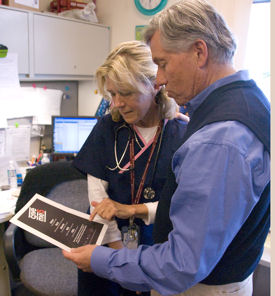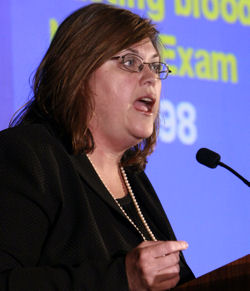Is your staff prepared to respond to a stroke?
Education about symptoms should target office staff with patient contact, as well as patients and relatives of those at risk.
Diana Fite, MD, was driving home after her shift in the emergency department when the right side of her body went weak and her car started to swerve. Kicking her right leg off the gas pedal and using her left hand to steer, the 53-year-old quickly pulled over to the side of the road. In disbelief, she looked in the visor mirror and tested her ability to smile—and saw only one half of her mouth move. That's when she finally accepted she was having a stroke.
“Because I am an emergency physician, I knew to call 911 to get help immediately,” said Dr. Fite, who made a full recovery. “But I know from my experience as a doctor that too many people ignore stroke symptoms or wait for them to go away, with tragic results.”
New research suggests that it is not only patients and bystanders who are unaware or dismissive of stroke symptoms. A troubling study presented at the American Stroke Association's annual International Stroke Conference in February found that nearly a third of receptionists in primary care offices would, if talking to patients who reported classic stroke symptoms, direct them to come in for a visit later in the day, rather than telling them to call 911.
“It's possible the results may have been even more dramatic in actual stroke circumstances,” said study co-author Todd Crocco, MD, emergency medicine specialist and professor at the West Virginia University School of Medicine. “Because we told the receptionists that we were researchers and that this was a hypothetical stroke case, it may have heightened their awareness.”
There was a spot of hope in the study results, however. When the researchers sought advice for hypothetical heart attack symptoms, the receptionists advised calling 911 100% of the time.
“As a nation, we have been talking about chest pain and heart attack for many more years than we have been talking about stroke. So the public—and that includes receptionists—has had more time to digest the message,” Dr. Crocco said. “We hope to raise that same sort of awareness about stroke.”
A campaign for all
Everyone from patients to medical office staff can benefit from a concerted effort to increase public knowledge about stroke, experts said. The “Give Me 5” stroke awareness campaign, announced in late March, aims to do just that.
Sponsored by the American Academy of Neurology (AAN), the American College of Emergency Physicians (ACEP), and the American Stroke Association (ASA), the campaign endorses a quick check of major stroke symptoms with five words: Walk (impaired balance), Talk (slurred speech or facial droop), Reach (weakness or numbness), See (impaired vision) and Feel (severe headache).
It also seeks to combine the best aspects of pre-existing stroke education efforts. The “Suddens” campaign, which gives a list of symptoms starting with the word “Sudden,” is inclusive but not catchy. And the “FAST” (Face, Arm, Speech, Time) campaign is memorable, but omits important symptoms like headache and vision problems.
“A national online survey of 1,000 people found that unaided recall of the five warning signs with ‘Give Me 5’ was twice as high as it was with the ‘Suddens,’” said Wendy Segrest, ASA's director of operations.
The hope is that the comprehensive “Give Me 5” will be catchy enough to be remembered, and that it will become the gold standard for public and patient education, both in doctors' offices and beyond, she added. The campaign's new Web site has resources that physicians can download to educate patients and their own staff, like brochures and posters.
Campaign organizers deliberately chose women—actress Morgan Fairchild and Dr. Fite—as spokespeople for the campaign, since women account for nearly 70% of deaths from stroke and are typically in charge of a family's health matters. In addition, research released at February's stroke conference showed the rate of stroke among middle-aged women tripled from 1988-1994 compared to 1999-2004.
“This surge of strokes in middle-aged women in a short period is very alarming,” said Ralph Sacco, MD, AAN board member. “The important message of the ‘Give Me 5’ campaign is early identification of stroke symptoms and early intervention by doctors in the emergency department.”
Getting to the hospital within three hours of a stroke is critical so that patients can be evaluated in time to receive tissue plasminogen activator (tPA) when appropriate.
Yet many in the general public are unaware of how critical the time element is, Dr. Fite noted.
“There's not as much of a sense of urgency as with heart attacks, which everyone knows can kill you,” she said. “People don't tend to think they can die from a stroke, and they also don't think about how devastating a lifetime of disability from a stroke would be.”
Educating office staff
Primary care offices are a crucial area for stroke education, as they are often a patient's first stop after stroke symptoms occur. An article in the January 2003 Stroke found that physician offices were a more common route of referral to acute stroke units than either ambulance staff or ED doctors. And a study presented at the 2008 International Stroke conference found that, in 22% of cases, a patient or bystander's first response to stroke symptoms was to call a doctor, not an ambulance.

“There were a lot of people who didn't feel they could make a decision to call an ambulance,” said Helen Dewey, MD, neurologist and co-author of the latter study. “They didn't think the problem was severe enough, or they didn't want to bother the emergency staff, so they were looking for some guidance on what to do.”
The study also found that 45% of doctors' offices advised patients to call an ambulance when they reported stroke symptoms, while 36% advised them to come in for a visit. Interestingly, doctors' offices were far more likely to advise calling an ambulance when someone called on the patient's behalf than when the patient called for himself or herself.
Ted Epperly, MD, president-elect of the American Academy of Family Physicians, said he's not surprised by the findings that receptionists and other medical staff sometimes fail to grasp that a patient is having a stroke and needs urgent attention.
“I think most practices don't specifically educate receptionists to recognize signs of stroke,” Dr. Epperly said. “I find a relative lack of understanding of stroke by many people in the health care system, from receptionists to patients to everyone in between.”
Physicians or nurses should make a point to tell receptionists to call or page them right away if they suspect a patient is having a stroke, he said. If, for some reason, no one is available to speak with the patient, the receptionist should advise the patient to hang up and call 911, he added.
It's also a good idea to have a card or poster with stroke symptoms in the front desk workspace which staff can glance at quickly while on the phone, said Kathy Eiler, a Philadelphia practice manager and faculty member on ACP quality improvement programs.
“With the big killers, like heart attack and stroke, you want to ensure staff has an easy-to-read reference right in front of them,” Ms. Eiler said. “They should be written in basic terminology that everyone understands.”
Health care professionals may also want to update their staff during office meetings about any new research or guidelines related to stroke, such as the fact that it's becoming more common among middle-aged women, or that women are more likely to present with diffuse symptoms, Dr. Crocco said.
“A 20-minute meeting to discuss the issue is a very reasonable way to approach it, as is having materials around the office,” Dr. Crocco said. “I'm not saying you have to do this for every disease process, but we're talking about the third largest killer, and one that is sometimes difficult to detect.”
Amazing things can happen when health professionals are tuned in to stroke symptoms. Paula Woodward, RN, senior clinical associate for ACP's Center for Practice Innovation, remembers phoning the wife of a patient several years ago to remind them both of an upcoming clinic, and noticing that the husband's voice in the background didn't sound right.
“I got the wife to put the husband on the phone, and I couldn't understand anything he was saying: His speech was slurred and he simply wasn't making sense,” Ms. Woodward recalled. “When I got him to put the wife back on the phone, I told her to call 911. Sure enough, it was a stroke.”
Educating patients and loved ones
Most physicians know they need to target patients at risk of stroke and educate them on signs and symptoms. That doesn't mean doctors or their staff always find time to do it, said Ed Jauch, MD, an emergency medicine physician and researcher in Cincinnati.
“One idea is, for the patients who are at risk of stroke due to hypertension or diabetes, to print up the warning signs of stroke on the back of their prescriptions,” Dr. Jauch said. “If they get the message in their primary care doctor's office, it will resonate more than in the ED, because there is an element of trust, a relationship.”
It's equally as important to target the at-risk patient's loved ones, as they are often the people who end up spotting stroke symptoms and calling for help. In the study co-authored by Dr. Dewey, stroke patients themselves called for help just 19% of the time; the rest of the time, it was a family member or other bystander who called on the patient's behalf.
“High-risk patients should not only have strategies in place to minimize the risk of stroke, but they and their family should also be aware of what to do if it happens,” said Ian Mosley, lead author of that study and a graduate student at the National Stroke Research Institute in Melbourne, Australia.
Primary care offices would be wise to encourage the relatives of at-risk patients to come in with the patient at his or her next appointment; speak with the relatives by phone about symptoms; or e-mail them information on stroke, Dr. Epperly suggested.
And educators should be sure to explain symptoms clearly, so a patient or loved one understands the difference between, say, an arm that's fallen asleep, and not being able to use one's hand to pick something up, said Dawn Kleindorfer, MD, neurologist and assistant professor at the University of Cincinnati.
“If someone falls on the ground and is suddenly paralyzed, it's obvious. But if a person suddenly becomes weak on one side, a lot of times that is blown off as having slept on it wrong,” Dr. Kleindorfer said. “You really have to make the distinction.”




